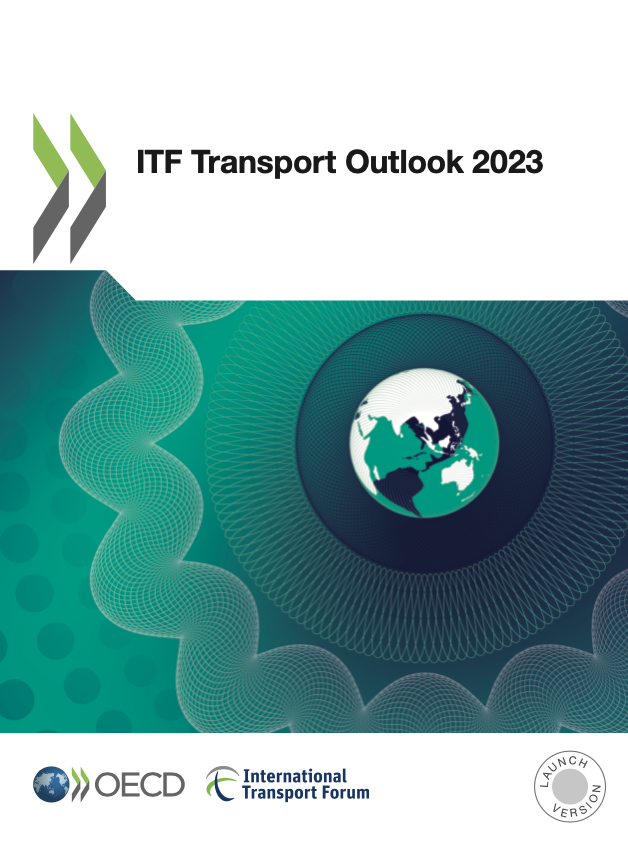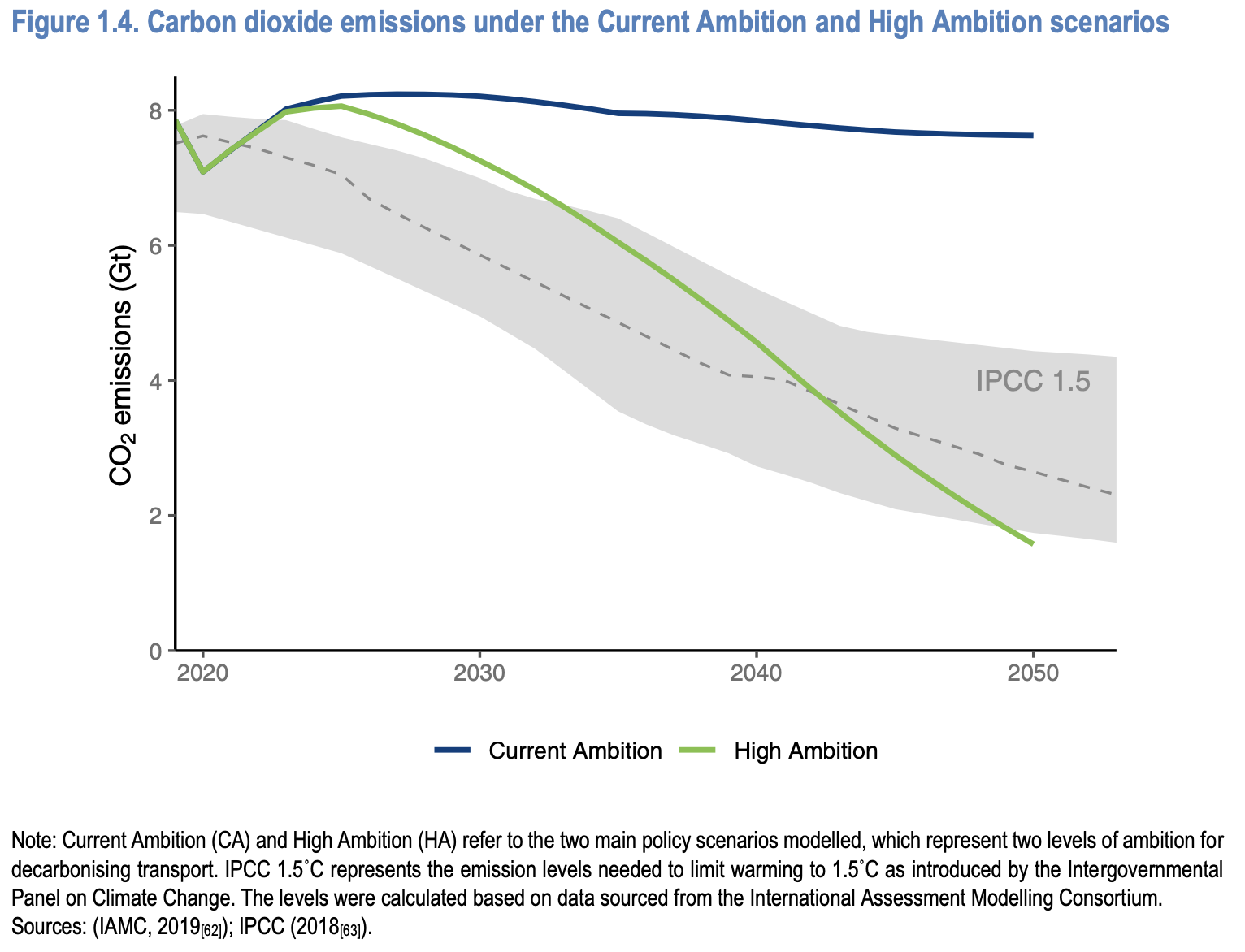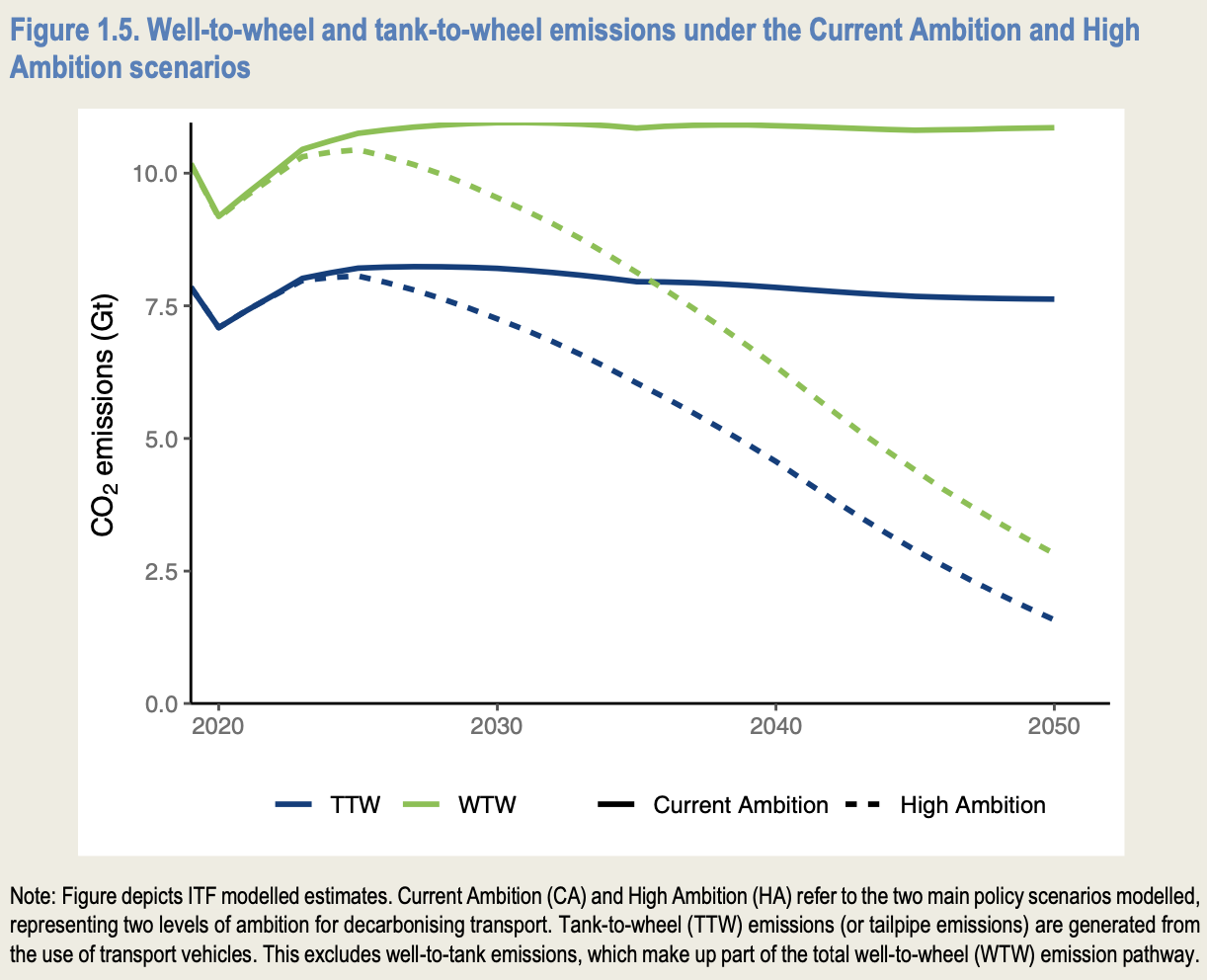TAPAS.network | 6 June 2023 | Review
ITF report spells out Global shortfall on meeting transport decarbonisation targets

This year’s major ITF Transport Outlook Report focusses on the global pathway to net zero transport and finds that the current trajectory is well short of meeting intended commitments
GLOBALLY, THE TRANSPORT SECTOR is not nearly on track to reach its decarbonisation goals and commitments, concludes a comprehensive international data and modelling overview of progress to date by the International Transport Forum, ITF. It points out that in 2015, parties to the United Nations Framework Convention on Climate Change (UNFCCC) concluded the Paris Agreement, a legally binding treaty to combat greenhouse gas (GHG) emissions and that by 2022, 193 countries plus the European Union had ratified it. Countries thus agreed to a goal to limit the increase in global average temperature to well below 2 degrees Celsius (°C) compared to pre- industrial levels, and pursue efforts to limit the temperature increase to 1.5°C.
The new report by ITF suggests that if transport carbon emissions alone were determining the temperature rise, the likely outcome would be a rise of 3 percent. To achieve the originally-agreed long-term goal, countries must aim to reach global peaking of emissions urgently, to achieve a climate-neutral world by mid-century, ITF stresses.
However, as shown in the key Figure 1.4 in the ITF report (reproduced below), based solely on commitments made to date, global transport emissions will not fall nearly fast enough to meet the Paris Agreement goals.

In fact, although several regions have taken concrete actions to deliver on their ambitions, continuing along the current path will result in a continued rise in the transport sector’s tank-to-wheel (TTW) CO2 emissions during the 2020s, culminating in just a slight fall, of 3%, by 2050 (see figure 1.5 from the ITF, reproduced below).

The approach and expertise behind the ITF carbon forecasts
The comprehensive and wide-ranging examination of global transport’s carbon challenge in the ITF Transport Outlook 2023 was led by the Research Centre at the ITF, but drew on the work of numerous individuals and partner organisations.
The modelling was led by the ITF’s Luis Martinez. Modelling colleagues included Matteo Craglia, Andrea Papu Carrone John Pritchard, Maya ter Laag and Mallory Trouvé. The project was managed by Orla McCarthy.
The report says the modelling approach was inspired by Professor Andreas Schäfer and Dr Tristan Smith of University College London Energy Institute, Professor Alan McKinnon, formerly of the University of Herriot-Watt and now at Kühne Logistics University, and Professor Lóránt Tavasszy of Delft University of Technology.
Other external contributors included Dr Paulo Anciaes, University College London, Professor Daniel Sperling, University of California Davis, and Professor Jose Viegas, Lisbon University.
The work drew upon modelling frameworks and methodologies developed by a number of organisations, including International Council for Clean Transportation, the International Maritime Organsiation, and the International Civil Aviation Organisation.
The policy scenarios in the report were influenced by surveys of transport experts in academia, industry, international organisations and government.
The 216-page report begins with an overview of the context in which the survey was developed, including the most pressing political, economic and demographic factors influencing transport demand and policy-making processes, and a review of what impacts were observed due to Covid.
This is followed by an overview of the assumptions underpinning the two policy scenarios explored — the Current Ambition and High Ambition alternatives — and the key results for demand and emissions projections.
Then comes a detailed look at the demand management and mode-shift policy measures included in the two policy scenarios, followed by an in-depth examination of the evolution of maritime, aviation and road vehicles and fuels and the policies required to increase low- and zero-emission transport.
The report then goes on to examine indicators for co-benefits of decarbonisation policies, including equity considerations. The indicators examined include emissions of other air pollutants; road safety; accessibility and affordability; and congestion and space consumption.
The work concludes with a look at the investment needs of infrastructure that would be required to cater to demand under the two scenarios, the charging networks potentially needed to support the uptake of electric vehicles envisaged, and the future of diminishing fuel-tax revenues.
It also introduces a conceptual approach to accounting for all of the transport sector’s emissions. This presents the idea of both ‘well-to-wheel’ and ‘tank-to-wheel’ emissions. Tank-to-wheel (TTW) emissions are defined as any emissions due solely to the energy used during a trip. Well-to-tank (WTT) emissions are those inherent in the production of the energy or fuel source used by vehicle fleets. Both TTW and WTT emissions represent the total emissions associated with a vehicle’s activity.
As shown in Figure 1.5, global WTW emissions were 30% higher than TTW emissions in 2019. As vehicle fleets become more efficient, the ITF report points out that WTT emissions will make up a larger share of total transport emissions than TTW emissions. The ITF Transport Outlook report focuses on TTW emissions to identify specific policies that will speed up decarbonisation in the transport sector, but says that greater collaboration with the energy sector to decarbonise fuel and energy production and distribution will remain critical to achieving global climate goals.
The 216-page ITF work is seemingly the most definitive analysis undertaken so far of the trajectory to decarbonisation of global transport yet available, and was presented to the international organisation’s 66 member Governments at its 2023 gathering in Leipzig at the end of May. It was produced by an extensive team of international experts, including modellers in all the relevant transport sectors, including road transport, aviation and maritime.
The report refers to the Intergovernmental Panel on Climate Change (IPCC) estimates as providing a sobering benchmark. Restricting the global average temperature increase to 1.5°C will require reducing total transport emissions to just 2- 3 gigatonnes by 2050. Additionally, the IPCC analysis suggests that transport needs to decarbonise faster than any other sector – a reduction of 70-80% below 2015 amounts – to achieve the necessary levels for the Paris Agreement. The ITF work indicates that it is actually doing worst than other sectors.
The ITF Transport Outlook 2023 report models two scenarios for future transport policies and their potential impacts on demand and emissions through to 2050. The Current Ambition scenario represents the business-as-usual approach. It projects the potential effects of existing commitments, including Nationally Determined Contributions made under the Paris Agreement.
In contrast, the High Ambition scenario assumes policy makers take accelerated action to decarbonise transport. This scenario models the impact of specific additional policy objectives, including providing alternatives to private motorised vehicles, enhancing public transport services, improving walking and cycling facilities, and improving the efficiency of the movement of goods.
As things stand, ITF acknowledges some regions’ current efforts will make a difference over time and overall transport CO2 emissions will fall slightly by 2050. However, a business-as-usual approach will not make enough difference to deliver against the Paris Agreement goals. The projections also show that the carbon-intensity of passenger activity falls faster than freight’s under the Current Ambition scenario.
Without decisive action, the transport sector will continue to contribute significantly to the world’s CO2 emissions, the ITF concludes. “The need to break the link between emissions and transport activities is increasingly urgent” it says. “Achieving decarbonisation in the transport sector will require increased policy ambition and international co-operation”. ITF acknowledges solutions for specific transport types, and economic and geographic contexts, will vary.
The International Energy Agency states that decarbonisation needs to begin immediately, with transport CO2 emissions already needing to fall by 3% per year through to 2030 to achieve Net Zero by 2050. The High Ambition scenario modelled by ITF suggests that the world could reduce its transport emissions by 80% by 2050, but achieving this reduction will require much more ambitious policies and faster actions that combine a mixture of mode shift, demand management and vehicle and fuel improvement measures than anything in progress so far.
The Paris Agreement includes a mechanism for countries to put forward plans for decarbonising their economies, and how they will play their part in delivering the goals of the agreement, known as Nationally Determined Contributions (NDCs; see Box 1.2). Under the agreement, parties to the UNFCCC were to renew their NDCs in five-year cycles, thereby showing increasing ambition and updated targets over time.
The COP 26 held in Glasgow in 2021 marked the end of the first five-year cycle of NDCs. ITF analyses of the NDCs submitted at COP26 show that a number of countries increased their commitments to transport decarbonisation in time for the conference. Notably, by COP26, the number of countries mentioning transport had “risen by 19 percentage points, those who list measures by 22 percentage points and those setting targets by eight percentage points”, compared to countries’ initial NDC submissions the ITF earlier concluded.
However, updates on overall GHG reduction targets at COP26 were still deemed to be insufficient. As a result, the COP26 agreement now requires countries to update their NDCs on an annual basis. In the year following COP26, only 32 parties to the UNFCCC (or 16%) provided updates to their NDCs in time for COP27, states ITF. It records that the UN IPCC has recently noted that countries’ efforts to bend the emissions curve downward are not yet enough to limit the global temperature rise to 1.5°C by the end of the century.
The ITF report identifies six ‘Breakthrough Goals’ that would mark material progress to Net Zero
-
Zero-emission vehicles (ZEVs) make up 100% of bus sales in leading markets by 2030
-
ZEVs make up 100% of heavy-goods vehicles sales in leading markets by 2040
-
ZEVs make up 100% of passenger vehicle and van sales in leading markets by 2035
-
Zero-emission fuels make up 100% of shipping fuels by 2050
-
Sustainable aviation fuels make up 100% of fuels globally by 2050
Although decarbonisation of the transport sector is an international priority, in many countries, it is only one among many priorities for governments looking to improve their economies and the quality of life of their citizens, ITF acknowledges. For many developing countries, reducing transport emissions must be considered in the context of other strategic priorities. Examples include enhanced connectivity, better road safety, improved road networks, digitalisation and provision of public transport and basic transport infrastructure.
But in these parallel objectives low-carbon transport measures have many potential co-benefits, ITF says. “Crucially, they can help achieve other economic and social objectives – including include enhanced equity and accessibility, improved health and safety, reduced air and noise pollution and reduced congestion – while accelerating the sector’s green transition.” Policy makers must threfore aim to maximise opportunities that meet the overall goals of the transport sector while moving to a low-carbon future.
The ITF is also involved in the cross-sectoral Energy Demand changes Induced by Technological and Social innovations (EDITS) project. This project looks at a low energy demand scenario for the future, which incorporates “major lifestyle, behaviour, infrastructure, and business model transformations” to reduce global energy use by 2050, and also improve equity and the outcomes of the Sustainable Development Goals.
With rapid urbanisation and the continued increase in demand for both passenger and freight transport, governments also have the pressure of increasing investment in urban transport infrastructure to meet this growing demand, ITF notes. Expanding urban areas, especially in developing and emerging economies, necessitate the construction of urban road networks, transit systems and transport terminals.
It hopes cities worldwide will adapt to the increase in demand for transport sustainably. Examples include efforts to create bus rapid transit (BRT) corridors, light rail transit, and expansion and electrification of public transport fleets. Integrated land-use planning and planning for transit-oriented development also help ensure that the increased demand is met while improving access and sustainability of urban mobility, ITF recommends.
“An integrated, connected and inclusive active-transport system contributes significantly to a clean mobility vision “ the ITF report says. Besides improved public transport alternatives, enhancing the infrastructure for active mobility is a priority for many European countries and some countries in Asia and Latin America. The focus in these countries has been the improvement of active mobility options through enhanced cycling and walking infrastructure and the reallocation of urban space.
Finally, low-carbon solutions must remain on transport ministries’ global agendas. Examples of these solutions include electrification and encouraging the switch to cleaner fuels to reduce the sector’s climate impact. As the transport sector is seen as a driver of economic growth and social inclusion, being a high-emitting sector, it will be essential to ensure that it plays its role in climate change mitigation and adaptation, says ITF.
Achieving the sustainability goals of the transport sector necessitates bearing in mind the entire scope of outcomes throughout the different stages of planning, designing and delivering both personal mobility and freight transport projects and programmes. Investments in solutions such as cleaner technologies and fuels, high-quality public transport fleets, well-planned and connected cities, and widely available active mobility options can help achieve transport ministries’ development goals and simultaneously fulfil their climate targets, ITF says.
“As time runs out to meet climate goals, the case to accelerate action is undeniable” its report concludes.
The transport sector accounts for 23% of the world’s energy-related CO2 emissions. Transport also indirectly contributes to increased demand for energy. Transport infrastructure construction, vehicle manufacturing and fuel production generate greenhouse gas emissions. And the sector locks in future emissions because of the longevity of vehicle fleets and infrastructure.
“The transport sector is a significant part of the global economy. It provides access to opportunities that contribute to countries’ and individuals’ economic and social well-being” the ITF acknowldeges. ”But transport faces a critical challenge: how to meet increasing demand while reducing carbon dioxide (CO2) emissions. Tackling poor air quality, reducing congestion and improving equity are equally important tasks for the sector globally.”
Tracking transport decarbonisation since the Paris Agreement
The ITF launched its Decarbonising Transport initiative in 2016, shortly after the signing of the Paris Agreement. Since then, the ITF has tracked countries’ submissions to the United Nations Framework Convention on Climate Change (UNFCCC). These submissions, known as Nationally Determined Contributions (NDCs), define countries’ pledges to reduce greenhouse gas emissions. The ITF’s Transport NDC Tracker, available online, provides information on the NDCs’ transport content.
The ITF’s Transport Climate Action Directory, launched in 2020, meanwhile provides policy makers with a tool to identify transport CO2-reduction measures that can translate their decarbonisation ambitions into actions and achieve their climate objectives. The UNFCCC has endorsed the directory as a tool that can help decision makers define measures when revising their NDCs or defining national transport decarbonisation plans.
Read the full ITF Transport Outlook 2023 report.
Further input to the discussion would be welcomed.
This article was first published in LTT magazine, LTT870, 6 June 2023.
You are currently viewing this page as TAPAS Taster user.
To read and make comments on this article you need to register for free as TAPAS Select user and log in.

Log in